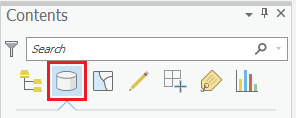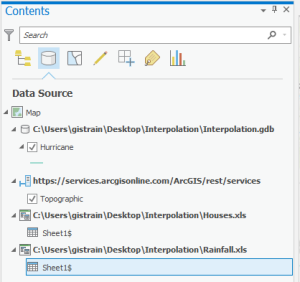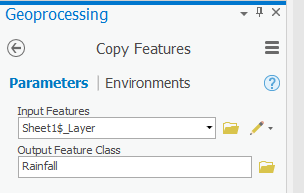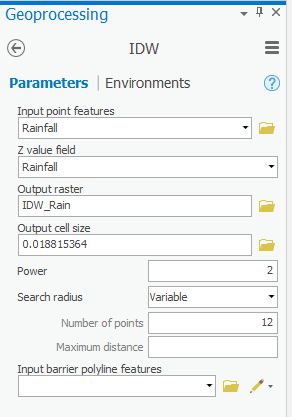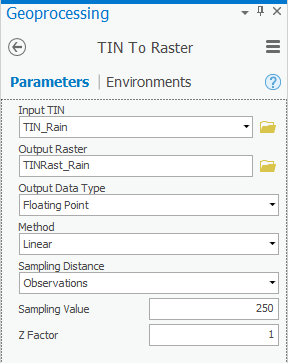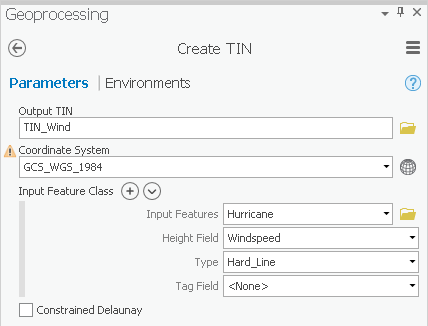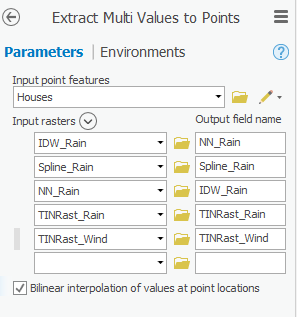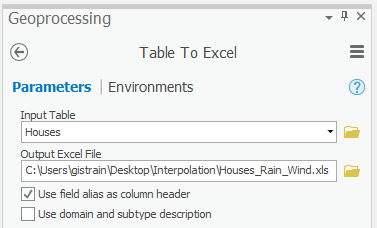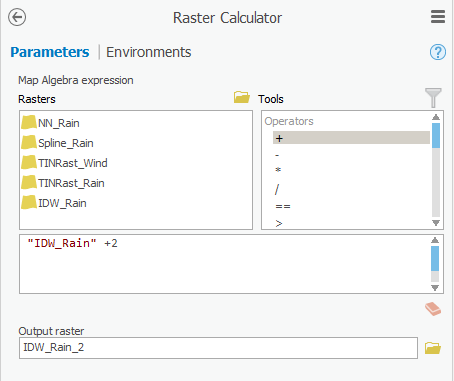...
- On the Desktop, double-click the Computer icon > gisdata This PC > GISData (\\file-rnassmb.rdf.rice.edu\research\FondrenGDC) (RO:) > > GDCTraining > 1_Short_Courses > > Data_Interpolation_and_Extraction.
- To create a personal copy of the tutorial data, drag the Interpolation folder onto the Desktop.
- Close all windows.
...
- At the top of the Contents pane, click the List By Data Source button.
- If you cannot see the entire file paths, hover over the right edge of the Contents pane until your cursor turns into a double-sided arrow.
- Click and drag the right edge of the Contents pane to the right until you can see the full file paths.
Now you can see the name of the Excel file from which each Sheet1$ originated, but to avoid further confusion, you will rename the Excel worksheet layers. This action will not rename the worksheets in the actual Excel file, but only how they are listed in the Contents pane in this particular Map.
...
- In the Contents pane, right-click the Sheet1$_Layer layer and select Data > Export Features.
- For ‘Output Feature Class:’, rename the feature class from “Sheet1Sheet1_Features_CopyFeatures” to CopyFeatures to “Rainfall”.
- Ensure your ‘Copy Features’ window appears as shown below and click Run.
...
- At the top of the Contents pane, click the List by Drawing Order button.
- Click and drag the right edge of the Contents pane back to the left, so that it is only wide enough to display the short layer names and the List by... icons.
Interpolating Data
Interpolation allows you to estimate the values of new data points based on the values of existing data points. In this case, you would like to estimate the rainfall values at each of the house locations based on the rainfall values recorded at each of the rain gauge locations. The following section will teach you several methods of interpolating both point and line vector data into raster datasets, which provide estimated values of the data variables across the entire region. You will see how these different interpolation techniques lead to variations in the resulting raster datasets. It is important to select an interpolation technique best suited to your existing data and your desired analysis.
...
- At the top of the Geoprocessing pane, click the Back arrow button.
- At the top of the Geoprocessing pane, click the Toolboxes tab.
- Click the Spatial Analyst Tools toolbox > Interpolation toolset > IDW (Inverse Distance Weighted) tool.
- For ‘Input point features’, use the drop-down menu to select the Rainfall layer, which contains your rain gauge point locations.
- For ‘Z value field’, use the drop-down menu to select the Rainfall field that contains the rainfall measurements you wish to interpolate.
- For ‘Output raster’, rename the exported raster from “IdwIdw_Rainfall1” to Rainfall1 to “IDW_Rain”.
- Ensure that your 'IDW' tool Parameters tab appears as shown below and click Run.
...
- In the Contents pane, right-click the IDW_Rain layer and select Symbology.
- For ‘Symbology,’ use the drop-down menu to select Stretch.
For ‘Color scheme’, use - Click the drop-down Color scheme menu. Select the Show names check box at the bottom.
- Scroll down the color scheme list and select the Blues (Continuous) box to select a continuous blue color ramp.
You can now see the continuously interpolated raster containing rainfall values that were generated using the data collected at the specific rain gauge points. Notice how this IDW method results in distinct rings around each input data point, because it treats each data point as a local max or min.
...
- At the top of the Geoprocessing pane, click the Back arrow button.
- Within the 3D Analyst Tools toolbox, collapse the Data Management toolset.
- Within the 3D Analyst Tools toolbox, click the Conversion toolset > From TIN toolset > TIN To Raster tool.
- For ‘Input TIN’, use the drop-down box to select the TIN_Rain TIN.
- For ‘Output raster’, rename the exported raster from “tintin_rain_tin” to tin to “TINRast_Rain”.
- Ensure that your 'TIN To Raster' tool Parameters tab appears as shown below and click Run.
- In the Contents pane, uncheck the TIN_Rain layer.
- Repeat the steps within the 'Inverse Distance Weighted Interpolation Method' section above to symbolize the TINRast_Rain layer as you did the other raster layers.
...
- In the Contents pane, check the Hurricane layer to make it visible.
- At the top of the Geoprocessing pane, click the Back arrow button.
- Within the 3D Analyst Tools toolbox, collapse the Conversion toolset.
- Within the 3D Analyst Tools toolbox, click the Data Management toolset.
- The TIN toolset should already be expanded, but, if not, click the TIN toolset.
- Click the Create TIN tool.
- For ‘Output TIN’, type “TIN_Wind”.
- For ‘Coordinate System’, use the drop-down menu to select the Houses layer.
- For ‘Input Features’, use the drop-down menu to select the Hurricane feature class.
- For ‘Height Field’, use the drop-down menu to select the Windspeed field.
- Ensure that your 'Create TIN' tool Parameters tab appears as shown below and click Run.
Again, you need to convert the TIN to a raster, so that it is comparable to the other interpolation layers.
- Repeat steps 9-16 above 1-8 regarding TIN to raster conversion in the 'TIN Interpolation Method' section above, but select TIN_Wind for the input TIN and name the output raster “TINRast_Wind”and uncheck the TIN_Wind” layer.
- In the Contents pane, click the arrow next to all of the raster and TIN layers to collapse their symbologies.
...
All of the raster interpolations you have created for wind and rain provide continuous value estimates over the entire hurricane area, but you are only interested in the data values at the particular locations of the individual houses filing insurance claims. You will extract point data for each of the house locations from each of the five raster layers you just created in a database-compatible format for the insurance company to use. Extracting data is one of the most important aspects of data manipulation, since interpolation is often useless if the results cannot be taken out of GIS and used for other procedures.
Extracting Multi Values to Points
- At the top of the Geoprocessing pane, click the Back arrow button.
- CollapseIn the Toolboxes tab, collapse the 3D Analyst Tools toolbox.
- Click the Spatial Analyst Tools toolbox > Extraction toolset > Extract Multi Values to PointsPoints tool.
- Use the For ‘Input point features’, use the drop-down box to select the Houses layer.
- Use the For ‘Input rasters’, use the drop-down box to select all five interpolation rasters you created earlier one at a time: IDW_Rain, Spline_Rain, NN_Rain, TINRast_Rain and TINRast_Wind.
The order in which the rasters are listed is the same order in which the extracted value columns will appear in the output feature class attribute table.
- Check Bilinear interpolation of values at point locations to further interpolate the value, if the house point does not lie exactly at the center of a raster cell.
- Ensure that your 'Extract Multi Values to Points' tool Parameters tab appears as shown below and click Run.
...
Notice the five new fields added to the end of the existing attribute table which contain the values of each of the five rasters at each house location. Notice also the differences in rainfall estimates resulting from the four different interpolation techniques. At many house locations, the value of the Spline spline interpolation is the most different from the other interpolation method values.
You are now ready to export the data table into a format that can be used by the insurance company, without having to use ArcGIS software.
- At the top of the Geoprocessing pane, click the Back arrow button.
- Click the Conversion Tools toolbox > Excel toolset > Table To ExcelExcel tool.
- For ‘Input Table’, use the drop-down menu to select the Houses attribute table.
...
- For ‘Output Excel File’, rename the Excel file from “HousesHouses_TableToExcel” to TableToExcel to “Houses_Rain_Wind”.
- Check Use field alias as column header.
- Ensure that your 'Table To Excel' tool Parameters tab appears as shown below and click Run.
...
Note that if you simply wanted a table containing the values of multiple rasters at each point and did not care about symbolizing or working with the points any further in the ArcGIS Pro environment, you could have used the Sample tool, which outputs a separate table, rather than adding the values to the end of your existing feature class attribute table.
...
For this example, you have learned that the rainfall data collected from the rain gauges had a common discrepancy. Each gauge misrepresented the rainfall amount by two inches uniformly across the state. There are several ways you could approach this problem, but you will add two inches uniformly across the interpolated rain raster to practice using the raster calculator.
- In At the top of the Geoprocessing pane, click the Back arrow button.
- Within in the Spatial Analyst Tools toolbox, click the Map Algebra toolset > Raster Calculator tool.
- Under ’Rasters’, double-click the IDW_Rain layer.
- Under ‘Operators’‘Tools’, double-click the + operator.
- Type "2".
- For ‘Output raster’, rename the exported raster from “idwidw_rain_ras” to ras to “IDW_Rain_2”.
- Ensure that your 'Raster Calculator' tool Parameters tab appears as shown below and click Run.
While the original IDW_Rain layer and the new IDW_Rain_2 layer will look the same visually, notice in the Contents pane, next to the continuous color ramps for the two layers, that the max and min values for the IDW_Rain_2 layer are now two higher than the max and min values for the original IDW_Rain layer.
You have now learned multiple methods of interpolating point and line data into raster data and extracting that raster data at corresponding point locations. You have also reviewed skills from other short courses, including Mapping Locations Using XY Coordinates.
...
